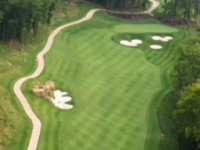The Spring 2014 Club Golf Season kicks off this weekend and it is going to be a quick and very cold, start.
This weekend’s Central Regional Club Golf Tournament takes place on March 1st and March 2nd at Payne Stewart Golf Club in Branson, Missouri. The Payne Stewart Golf Club is a par-72 course that measures at 7046 yards from the green tee boxes. Pairings and other tournament information can be found on the NCCGA website. The Mizzou Club Golf Team enters the season and the tournament ranked No. 16 in the NCCGA Preseason National Rankings. They are looking to defend their Central Region crown after winning both tournaments last semester by an average of 16.5 strokes after beating out Missouri B-Team in the first regional and Iowa State in the second regional tournament.
Iowa State comes into this regional ranked in the top-50 as well, sitting at No. 40, just behind the Arizona State Sun Devils. As No. 16 Mizzou looks to make a run at a second straight appearance at the NCCGA National Tournament, No. 40 Iowa State looks to challenge their dominance. Whatever the outcome, the Central Region has made its presence on the National Stage, and looks to do so again this semester. Now we will take a look at the weather forecast for this weekend’s tournament.
Weather Forecast
The forecast for this weekend starting with Saturday, there will be showers with a high of 47 and a low of 30 degrees with an 8 mile per hour wind out of the east. Sunday looks like the conditions will worsen for us with an 80 percent chance of light rain, a high of 39 and a low of 20 degrees. Be careful if you plan on traveling late Friday, because there is a 60 percent chance of light rain and freezing rain. Please note that the weather is subject to (and hopefully will) change.
The Course
The tournament is most likely going to be played off of the Green tees, which puts the yardage at 7046 yards.
- Hole #1
- We tee off the number 1 hole measuring at 439 yards. It is a dog-leg left par-4 that you need to carry the left fairway bunker 220 yards to set yourself up nicely for the approach to the green. A great drive can leave you anywhere from 150 to 190 yards to this tight green, so be sure to get it in the fairway.
- Hole #2
- Number 2 is a long, 215-yard par-3 that is guarded by two, front-right bunkers. It is an elevated tee shot, so it will play shorter than it looks. If you do happen to miss the green, you want to be left to avoid the bunkers.
- Hole #3
- Number 3 can be a tricky hole. If you have a huge drive, and you are consistent with it, you could potentially drive the green on this downhill, 313-yard par-4. However, don’t let your ego get the best of you, which is what I typically do and it ends badly for me. My personal tendencies aside, play it safe and take an iron off the tee and drop it into the middle of the fairway. A 200-yard tee shot will leave you with about 100 yards into the green. This is a classic “Cost/Benefit Tee Shot” that will definitely take a cost/benefit analysis. Don’t forget to take the sand, water, and natural rock cliffs into account for your tee shot.
- Hole #4
- Hole number 4 may come as a relief as the first par-5, but don’t get carried away too quickly. This tee shot has a lot of water that will be in play with your tee shot and your approach into the green. This is not a reachable green in 2 shots unless three things happen, not necessarily all together: 1. The wind is with you. 2. You have a perfect tee shot and a perfect second shot. 3. You drop bombs with your driver. If you drop bombs with your driver and you decide to go with it, you better hope that it is perfectly placed in the fairway. You have to hit the ball 295 yards to clear the first fairway bunker on the left side of the fairway, so it may not even be an issue for some of us. After a decent tee shot, it will take anywhere from 150 to 220 yards to set up your third shot nicely. This can be a costly hole if it is not played smart.
- Hole #5
- The par-4, fifth hole is going to be interesting. This is potentially going to be the most difficult tee shot that you will have to hit all round. This hole is the #3 handicap hole that stands at 449 yards long with a road lining the left side of the hole. There is a large rock that is sitting above a fairway bunker that provides a good waypoint to aim your tee shot at. This will keep the right side trouble (more) out of play and will careen your ball back to the center of the fairway. There is however, three bunkers in front of the green, so stick it close.
- Hole #6
- This is a straightaway, 404-yard par-4. The tee shot is fairly simple with trouble to your right and left, so a straight drive down the middle will give you your best opportunity at making par. There are two bunkers in front of the green with one bunker on the back-left side of the green. Hitting into any one of these bunkers will ensure you get a bogey on this hole. Especially if the pin is in the back-right tier of the green.
- Hole #7
- The par-3 seventh is by far, the shortest hole on the course, at 140 yards. Although it is the shortest hole, it requires an accurate tee shot because it has a very undulated green, which can be very tricky should you miss the green, or heaven forbid you find the greenside bunker.
- Hole #8
- The eighth is a 527-yard par 5 in which you should try to land your tee shot on the left side of the fairway, but it is a hidden landing area. The fairway bunker comes into play at 290 yards, so it won’t come into play for most of us. This is a reachable green, but it requires two great shots. Par should come easy on this hole and it will be a relief if you have had a rusty start to the spring season.
- Hole #9
- On the par-4 ninth, you will want to take in the sights. It will be one of the best views all day, which can be relaxing and help you turn around your round. Your drive needs to be along the left side of the fairway in order to leave you with a good angle into the green. You want to set yourself nice because there is a waterfall and a creek that passes in front of the green.
- Hole #10
- Number 10 is going to need an accurate tee shot to keep you out of trouble. Try to avoid the right fairway bunkers, but if you are going to miss to the right, you better hope that your ball finds the bunker; otherwise you will not find your ball. A good tee shot will give you 150-170 yards into the green and a good chance for birdie.
- Hole #11
- The first par five of the back nine will be challenging. It is a long, 578-yard uphill par-5 that will likely require three well-executed shots. There are several fairway bunkers that prevent even the best of golfers from taking the high risk of going for the green in two. A great drive off the tee will still leave about 260 yards to the green; so laying up is the safest option. You definitely want to think about where you will place your second shot because, depending on the pin location, you could be left with a three-putt if you end up on the opposite side of the green.
- Hole #12
- The number 12 par-3 is going to a difficult. With guarding the front right and front left of the green, accuracy is going to be crucial to making par on this hole. You definitely want to avoid the bunkers, but above all, DON’T HIT INTO THE WATER!!!
- Hole #13
- The thirteenth hole, par-4 starts with an elevated tee shot that will not be able reach the fairway bunker that sits 329 yards away from the tee box. A solid 280-yard drive will leave you with 116 yards into the green. This should be an easy par with a chance to dabble in the red numbers with a birdie.
- Hole #14
- The last par-5 is hole number 14, which offers another chance for a birdie. The tee shot is relatively easy, but there is trouble to the left. The best option is to keep your tee shot to the left of the fairway. However, the layout of the hole will likely leave your second shot with an uneven lie. If you value your score, you will lay up because your tee shot will leave you with about 270 yards. So laying up with a second shot of 180 yards will leave you with less than 100 yards into the green to set you up nicely for birdie.
- Hole #15
- The 413-yard, par 4, 15th hole is a downhill, dogleg left that requires an accurately placed tee shot if you want to score well on this hole. The fairway bunker comes into play at 306 yards, which will be out of reach for most of us. A drive of 280 yards will leave you with approximately 133 yards into the very deep green. Be sure to land your approach shot on the same tier as the pin to increase your chances at a birdie, however should you find yourself on the wrong tier, your chances are diminished.
- Hole #16
- The par-3, 16th hole measures our at 173 yards from the green tees and provides a chance to get par to pad the scoresheet before heading into the last two holes. The lake that guards the green to the right and in front of the tee boxes force you to miss right if you do not hit the green in regulation, but be careful of the back left green-side bunker that could cause you trouble. If you find yourself in the sand trap, your short game needs to be spot on because you cannot afford to hit into the water coming out of the bunker.
- Hole #17
- Two holes to go before you are finished with your round, but first, the par-4, 17th will require maximum concentration throughout the entirety of the hole. You may have to lay up if you want to play it safe because this hole requires two excellent shots for a chance at par. If you do not hit the fairway, your hopes at par may be dashed. The safe play is to take an iron off the tee, but if your drives have been solid all day, you may be able to stick with your driver, but it needs to be placed perfectly to have a good shot at the green. A tee shot into the middle of the fairway will leave you with about 160 yards into the green. Whatever you do, do not miss the green left because you are sure to end your round the wrong way.
- Hole #18
- If your round hasn’t had its problems yet, you are about to encounter the number 2 handicap hole as the finishing hole. Number 18 is a 421-yard par-4 that requires you to carry the fairway bunker on the left side of the fairway before it drops off. Not to worry, if you carry the bunker, your approach will be set up nicely and will leave you with about 150 yards into the final green, which could potentially set you up nicely to finish with a birdie. But if you are like me, play it safe and just try to two-putt for a par to end on a good note.
Everyone, try to stay this warm this weekend and good luck! I look forward to competing against and with some of you this semester. Don’t make the mistake I made last year and forget warm clothing. Prepare for all kinds of weather. After all, this is Missouri.
Keith Alexander plays on the Missouri Club Golf Team. He can be reached via Twitter at @MizzouKeith33.




